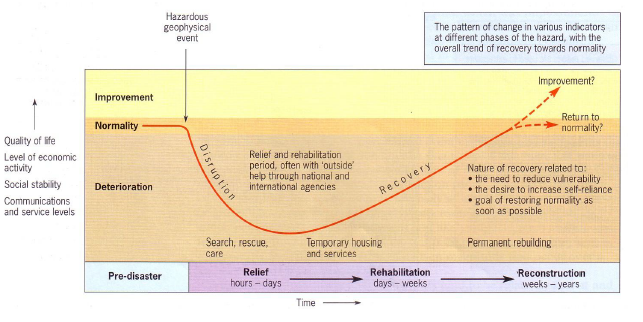Park's Model:
- This model shows the impact of a natural hazard over time
- Different hazard events have different impacts, shown by the speed of the drop in quality of life, the duration of the decline, and the speed and nature of recovery.
- The differences in the 3 lines might be related to type of hazard, degree of preparedness, speed of the relief effort and the nature of recovery and rebuilding.
- Pre-disaster; Relief; Rehabilitation; Reconstruction; same level?
- Haiti had a big onset and there hasn’t been much recovery so the line would drop shorter.
- Rapid onset is usually an earthquake
- Slower onset is usually a volcano as the ashfall effect could take weeks to develop.
Hazard-Management Cycle:
-
Response:Recovery:Mitigation:Preparedness:Action by the energy services, aid agenciesHelps to ‘modify the loss’Recusing buried or trapped peopleProviding shelter, food, clean water.MEDCs like the USA have excellent responses with helicoptersLEDCs like Haiti 2010 earthquake have poor response although international charities and aid from other countries e.g Oxfam, Red CrossIn the following weeks and months and years, the rebuilding process starts which is long and costlyJapan 2011 earthquake and tsunami was very expensive and slow but it was rebuilt better than before with more protection. Nuclear power station recovery could take years though.Haiti 2010 was very slow and many are still homeless 7-9 years later.Modifying the vulnerability and to try and reduce the riskAn effective type of disaster management: building codes, earthquake-proof buildings (aseismic) e.g NZ 2011 vs Haiti 2010.Also, includes strategies such as preventing the hazard but this can rarely be done e.g Lava flow in Hawaii.Includes warning systemCan be effective in saving lives especially if hazard has been predictedIncludes education, emergency kits at homeMEDCs are more prepared than LEDCs e.g California, USA and Japan have good preparedness whereas Haiti doesn’t.
